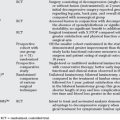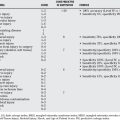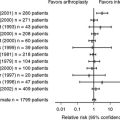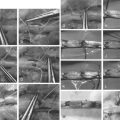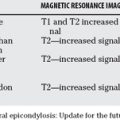Chapter 13 What Is the Best Treatment for Acute Injuries of the Scapholunate Ligament?
The scapholunate (SL) ligament is the fibrous structure that links the scaphoid and lunate bones of the wrist. It is composed of a thick and strong dorsal portion, a more pliable anterior portion, and finally an intervening membranous segment. It is the dorsal portion that plays the most important role for carpal stability.
An acute injury to the SL ligament alters the linkage between the two bones resulting in a dissociative carpal instability, also known as an SLD. This can present clinically in a variety of stages depending on the severity of the original injury and the delay to clinical diagnosis. There is no consensus for the nomenclature for the various patterns of severity of SL injuries. Predynamic SLD is a partial injury where the ligament remains intact. Symptoms arise from the associated increase motion, but there is no instability. Dynamic SLD is a complete disruption of the ligament when it is still repairable. No cartilage damage exists, and secondary stabilizers are intact. No permanent malalignment and demonstration of the radiographic gap between the scaphoid exists, and the lunate may require special maneuvers. The third manifestation is static reducible SLD. Secondary stabilizers have become deficient. The radiographic appearance is quite apparent, but the deformity can still be reduced. Eventually, the insufficiency results in static fixed SLD where it cannot be reduced. Finally, there is progression to degenerative arthritis with cartilage loss resulting in scapholunate advanced collapse (SLAC) wrist.1 The rationale for treatment of acute SL injuries is to prevent the progression to a SLAC wrist.
EVIDENCE
Predynamic Injuries
For acute predynamic SL injuries, this is primarily a diagnosis based on findings at the time of arthroscopy, and consistent symptoms and physical examination. No series in the literature have examined treatment of these patients conservatively either by observation alone or by casting. The evidence for percutaneous fixation for these injuries is limited to management review articles and book chapters.2–4
The evidence for arthroscopically guided fixation for acute incomplete injuries is also lacking. Studies for chronic symptoms and arthroscopic management of various types of wrist injuries have been reported; however, there are no acute injury case series.5–8 Whipple9 reported a non–peer-reviewed article on arthroscopically guided pin fixation in a series of 40 patients. In a subgroup of these 40 patients, with less than a 3-mm gap and less than 3 months of symptoms, 83% experienced symptom relief. However, the size of this subgroup and the severity of SL injury are not identified, and neither is the time from injury. Hirsh and colleagues10 have reported on arthroscopic electrothermal shrinkage for SL laxity in 10 patients, of which there were 2 that were less than 6 weeks after injury. The outcomes for these two patients are unclear.
Dynamic Injuries
Cast Immobilization.
Two case reports of successful management of an SLD associated with a distal radius fracture (DRF) managed by closed reduction and casting have been reported.11,12 However, Tang and coworkers,13 in a series of 20 patients with DRF and SLD, found at 1 year that 100% had clinical signs and positive radiographs. Eight patients underwent surgery at 1 year. Laulan and Bismuth,14 in a radiographic study of DRF in 29 patients with an SL injury treated by casting alone, found at 1 year that progressive carpal collapse occurred in 61% of patients.
K-Wire Fixation.
Treatment by temporary K-wire fixation alone has been reported by Peicha and coauthors15 in 11 patients. These all had concomitant intra-articular DRF. The 11 patients had a spectrum of SL injuries including 2 cartilage injuries, 7 partial ligament tears, and 2 complete ligament tears. They had follow-up on 6 patients, but the results are not published in relation to the type of injury. The study was updated in 1999 with a total of 12 patients. The number of cartilage injuries had changed to one, and there were two complete and nine partial SL injuries. Seven patients were available for follow-up. Results are not provided for the injury groups except for three scales where the complete injuries score are worse.
K-wire fixation for SLD has been reported in a series of 27 cases.16 In this series, the recurrence SL instability was found in 15 cases. The authors did not recommend this treatment for all cases but rather treatment to be tailored to severity of presentation.
Ligament Repair with or without Capsulodesis.
Ligament repair in acute cases has been reported using a Mitek anchor.17 There were 12 cases; however, only 2 were isolated SLDs, with the other being more complex perilunate injuries. It is not possible to determine the outcome of these two patients.
Ligament repair has been reported in children. Alt and coauthors18 describe ligament repair in three children at approximately 10 weeks. Successful, pain-free, full-function outcomes were reported at about 28 months after surgery.
Many articles reference Lavernia and colleagues’19 study. In this series of 24 cases, there were 24 patients treated with records for 21. The average time from injury to surgery was 17 months, so most of these records were not acute. Four had only a ligament repair, 14 repair and capsulodesis, and 3 a capsulodesis alone because the ligament was only attenuated. Patients did well at an average 33-month follow-up with regard to grip strength, pain, and satisfaction. It is not possible to determine the outcomes for the patients with acute injuries.
Wyrick and coworkers20 have reported on their experience with 24 patients treated on average 3 months after injury (range, 3 days to 16 months). Follow-up was available for 17 patients at an average of 30 months; 13 had repair of the ligament and capsulodesis, and 4 had only a ligament repair. No patient was pain free, and four required further surgery. It is not possible to determine results in relation to time from injury.
In a study examining ligament repair and capsulodesis, Minami and coauthors21 report on 17 patients with wrist ligament injuries; however, only 6 had an isolated SLD, and only 4 could be considered acute or subacute (15–45 days). These four patients did have reported good outcomes.
Other studies in the literature that examine outcomes of soft-tissue stabilization for chronic SLD, similar to Lavernia and colleagues’19 study, have reported favorable results using similar surgical techniques.22–25 However, these do not include acute management, and the spectrum of injury severity is variable. The different outcomes in the studies promote a favorable outcome for patients.
OTHER TYPES OF RECONSTRUCTION
Other forms of reconstruction have been described for the chronic state; however, their use in acute repair is quite limited.26–28 A bone-retinaculum-bone flap taken from the dorsal distal radius has been reported in 19 cases, 2 of which were acute injuries.23 For these two patients at a minimum follow-up at 24 months, one had no pain and the other had pain with heavy activity. Further specific results were unavailable.
A periosteal flap from the iliac crest has also been used acutely. Lutz and colleagues28 describe its reconstruction in 11 cases at an average of 15 months after trauma, 3 of which they describe as subacute, less than 6 weeks.24 It is not possible to determine the specific results for the acute group. Six of 11 were rated excellent to good results.
Dynamic
For patients with dynamic injuries, it would appear from my understanding of the natural history of this condition that no treatment will lead to progressive collapse over time, and this is unacceptable. The available case series indicate that cast immobilization alone does not alter the natural history. K-wire fixation series are limited, and this treatment does not appear to be of benefit because recurrence is more than likely.
The case series of more aggressive forms of surgical intervention for acute SLD do not provide a clear picture of the outcomes. The time to treatment, severity of injury, and the form of intervention are all variable and make interpretation difficult. However, it would appear that, on average, patients who had some form of surgical reconstruction/repair, capsulodesis and ligament repair being most common, were more likely to have a better outcome than cast immobilization or K-wire fixation alone. No clear evidence supports one form of surgical repair/reconstruction. Therefore, for patients with acute dynamic injuries, the recommendation would be that they undergo repair/reconstruction. Table 13-1 provides a summary of recommendations for the treatment of SLD.
| STATEMENT | LEVEL OF EVIDENCE/GRADE OF RECOMMENDATION |
|---|---|
| Adults with acute dynamic scaph-olunate dissociation should have ligament repair/reconstruction. There is no evidence to support a specific technique of ligament repair/reconstruction. | C |
1 Garcia-Elias M, Geissler WB. Carpal instability. In: Green DP, Pederson WC, Hotchkiss RN, Wolfe SW, editors. Green’s Operative Hand Surgery. Philadelphia: Elsevier Churchill Livingstone; 2005:555.
2 Linscheid RL. Scapholunate ligamentous instabilities (dissociations, subdislocations, dislocations). Ann Chir Main. 1984;3:323-330.
3 O’Brien ET. Acute fractures and dislocations of the carpus. Orthop Clin North Am. 1984;15:237-258.
4 Taleisnik J. Scapholunate dissociation. In: Strickland JW, Steichen JB, editors. Difficult Problems in Hand Surgery. St. Louis: CV Mosby; 1982:341-348.
5 Ruch DS, Poehling GG. Arthroscopic management of partial scapholunate and lunotriquetral injuries of the wrist. J Hand Surg [Am]. 1996;21:412-417.
6 Westkaemper JG, Mitsianis G, Giannakopoulas PN. Wrist arthroscopy for the treatment of ligament and triangular fibrocartilage complex injuries. Arthroscopy. 1998;14:479-483.
7 Weiss AP, Sachar K, Glowacki KA. Arthroscopic debridement alone for intercarpal ligament tears. J Hand Surg [Am]. 1997;22:344-349.
8 Earp BE, Waters PM, Wyzykowski RJ. Arthroscopic treatment of partial scapholunate ligament tears in children with chronic wrist pain. J Bone Joint Surg Am. 2006;88:2448-2455.
9 Whipple TL. The role of arthroscopy in the treatment of scapholunate instability. Hand Clin. 1995;11:37-40.
10 Hirsh L, Sodha S, Bozentka D, et al. Arthroscopic electrothermal collagen shrinkage for symptomatic laxity of the scapholunate interosseous ligament. J Hand Surg [Br]. 2005;30:643-647.
11 King RJ. Scapholunate diastasis associated with a Barton fracture treated by manipulation, or Terry-Thomas and the wine waiter. J R Soc Med. 1983;76:421-423.
12 Bell MJ. Perilunar dislocation of the carpus and an associated Colles’ fracture. Hand. 1983;15:262-266.
13 Tang JB, Shi D, Gu YQ, Zhang QG. Can cast immobilization successfully treat scapholunate dissociation associated with distal radius fractures? J Hand Surg [Am]. 1996;21:583-590.
14 Laulan J, Bismuth JP. Intracarpal ligamentous lesions associated with fractures of the distal radius: Outcome at one year. A prospective study of 95 cases. Acta Orthop Belg. 1999;65:418-423.
15 Peicha G, Seibert FJ, Fellinger M, et al. Lesions of the scapholunate ligaments in acute wrist trauma—arthroscopic diagnosis and minimally invasive treatment. Knee Surg Sports Traumatol Arthrosc. 1997;5:176-183.
16 Schadel-Hopfner M, Bohringer G, Gotzen L. Results after minimally invasive therapy of acute scapholunate dissociation. Handchir Mikrochir Plast Chir. 2000;32:333-338.
17 Bickert B, Sauerbier M, Germann G. Scapholunate ligament repair using the Mitek bone anchor. J Hand Surg [Br]. 2000;25:188-192.
18 Alt V, Gasnier J, Sicre G. Injuries of the scapholunate ligament in children. J Ped Orthop. 2004;13:326-329.
19 Lavernia CJ, Cohen MS, Taleisnik J. Treatment of scapholunate dissociation by ligamentous repair and capsulodesis. J Hand Surg [Am]. 1992;17:354-359.
20 Wyrick JD, Youse BD, Kiefhaber TR. Scapholunate ligament repair and capsulodesis for the treatment of static scapholunate dissociation. J Hand Surg [Br]. 1998;23:776-780.
21 Minami A, Kato H, Iwasaki N. Treatment of scapholunate dissociation: Ligamentous repair associated with modified dorsal capsulodesis. Hand Surg. 2003;8:1-6.
22 Pomerance J. Outcome after repair of the scapholunate interosseous ligament and dorsal capsulodesis for dynamic scapholunate instability due to trauma. J Hand Surg [Am]. 2006;31:1380-1386.
23 Shih J-T, Lee H-M, Hou Y-T, et al. Dorsal capsulodesis and ligamentoplasty for chronic pre-dynamic and dynamic scapholunate dissociation. Hand Surg. 2003;8:173-178.
24 Muermans S, De Smet L, Van Ransbeeck H. Blatt dorsal capsulodesis for scapholunate instability. Acta Orthop Belg. 1999;65:434-439.
25 Saffar P, Sokolow C, Duclos L. Soft tissue stabilization in the management of chronic scapholunate instability without osteoarthritis. A 15-year series. Acta Orthop Belg. 1999;65:424-433.
26 Garcia-Elias M, Lluch AL, Stanley JK. Three-ligament tenodesis for the treatment of scapholunate dissociation: Indications and surgical technique. J Hand Surg [Am]. 2006;31:125-134.
27 Weiss AP. Scapholunate ligament reconstruction using a bone-retinaculum-bone autograft. J Hand Surg [Am]. 1998;23:205-215.
28 Lutz M, Kralinger F, Goldhahn J, et al. Dorsal scapholunate ligament reconstruction using a periosteal flap of the iliac crest. Arch Orthop Trauma Surg. 2004;124:197-202.

